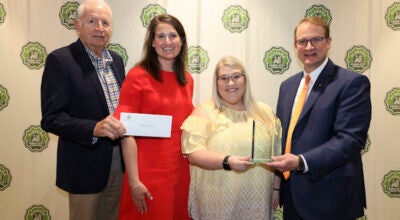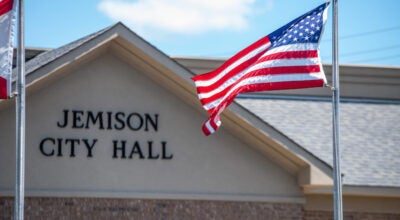Los Angeles mayor says 18 confirmed dead in commuter train collision, CA
Published 2:59 pm Saturday, September 13, 2008
LOS ANGELES (AP) – A commuter train engineer who ran a stop signal was blamed Saturday for the nation’s deadliest rail disaster in 15 years, a wreck that killed at least 24 people with more bodies still to be pulled from the smoldering, twisted metal.
A preliminary investigation found that “it was a Metrolink engineer that failed to stop at a red signal and that was the probable cause” of Friday’s collision with a freight train in Los Angeles’ San Fernando Valley, Metrolink spokeswoman Denise Tyrrell said. She said she believes the engineer, whose name was not released, is dead.
“When two trains are in the same place at the same time somebody’s made a terrible mistake,” said Tyrrell, who was shaking and near tears as she spoke with reporters.
Authorities later announced that the official death toll had risen to 24. More bodies remained in the wreckage of a Metrolink passenger car but it was difficult to determine how many, Mayor Antonio Villaraigosa told a press conference when the toll was at 23.
“It’s like peeling an onion,” he said of efforts to get through the wreckage.
A total of 135 people were injured, with 81 transported to hospitals in serious or critical condition. There was no overall condition update available Saturday, but a telephone survey of five hospitals found nine of 34 patients still critical. Many were described as having crush injuries.
Deputy Fire Chief Mario Rueda said the chance that anyone was still alive in the wreckage was “very remote.” The last survivor was pulled out Friday evening, said fire Capt. Armando Hogan.
“Words can’t explain or in any way console those who have lost loved ones, those who at this moment still don’t know what the condition or status of their loved ones is,” Villaraigosa said at a news conference. “I can only tell you that these firefighters and police officers have worked feverishly through the night.”
The collision occurred on a horseshoe-shaped section of track in Chatsworth at the west end of the San Fernando Valley, near a 500-foot-long tunnel underneath Stoney Point Park. There is a siding at one end of the tunnel where one train can wait for another to pass, Tyrrell said.
“Even if the train is on the main track, it must go through a series of signals and each one of the signals must be obeyed,” Tyrrell said. “What we believe happened, barring any new information from the NTSB, is we believe that our engineer failed to stop … and that was the cause of the accident.
“We don’t know how the error happened,” she continued, “but this is what we believe happened. We believe it was our engineer who failed to stop at the signal.”
Tyrrell said Metrolink determined the cause by reviewing dispatch records and computers.
National Transportation Safety Board member Kitty Higgins said her agency, which is leading the probe, is waiting to complete its investigation before making any statements about the cause of the accident. It hopes to complete its final report within a year.
Higgins said rescue crews on Saturday recovered two data recorders from the Metrolink train and one data recorder and one video recorder from the freight train. The video has pictures from forward-looking cameras and the data recorders have information on speed, braking patterns and whether the horn was used.
The Metrolink train, heading from Union Station in downtown Los Angeles to Ventura County, was carrying 220 passengers, one engineer and one conductor when it collided with the Union Pacific freight, with a crew of three, about 4:30 p.m. Friday. It is common in California for freight and commuter trains to use one track.
The crash forced the Metrolink engine well back into the first passenger car, and both toppled over. Two other passenger cars remained upright.
By late Saturday morning, the Metrolink engine had been pulled out of the mangled passenger car, which was raised by a crane and surrounded by tarps. Bulldozers pulled away chunks of metal.
Fire Capt. Steve Ruda said his firefighters had never seen such carnage.
“It’s the worst feeling in the world because you know what you’re going to find,” said fire Capt. Alex Arriola, who had crawled into the bottom of the smashed passenger car. “You have to put aside the fact that it’s someone’s husband, daughter or friend.”
Police set up what they called a unification center at a local high school to try to connect worried people with information about friends or relatives who they believed were aboard the train.
Families of eight of the dead had been notified and two women who were pronounced dead at hospitals were unidentified, coroner’s Assistant Chief Ed Winter said.
Worried relatives and friends gathered at nearby Chatsworth High School to wait for news as rescue workers delicately dismantled the passenger car.
“That was her train and she’s not home,” said Debra Nieves said of her sister, Donna Remata, 49. “But until I find out for sure that they found her, I’m not going to leave.”
Firefighters were rotated in and out of the scene to prevent emotional exhaustion, said Hogan, the fire captain.
“There are some things we are trained for, there are some things I don’t care what kind of training you have, you don’t always prepare for,” Hogan said. “This situation, particularly early on, with people inside the train, with the injuries, and with people moaning and crying and screaming, it was a traumatic experience.”
Tyrrell, the Metrolink spokeswoman, said the engineer had driven the agency’s trains since 1996 and worked for a subcontractor, Veolia, since 1998. She said she didn’t know if the engineer ever had any previous problems operating trains or had any disciplinary issues.
Veolia issued a statement Saturday calling the collision a “tragic incident.”
“We are putting every available resource behind the efforts to assist emergency personnel and our client in rescue and recovery efforts,” the statement said.
Ray Garcia, a train conductor with Metrolink until 2006, said he knew the engineer involved in the crash for nine years and called him qualified and talented. He declined to name the engineer.
“I’m very sad that that happened,” Garcia said. “It’s terrible.”
Garcia said he knows the stretch of track where the collision occurred and believes engineers are warned twice with yellow lights before reaching a red light at the end of a siding.
Tim Smith, state chairman of the Brotherhood of Locomotive Engineers and Trainmen, a union representing engineers and conductors, said issues that could factor into the crash investigation could be faulty signals along the track or engineer fatigue.
He said engineers in California are limited to 12 hours a day running a train, although that can be broken up over a stretch as long as 18 hours.
“Doing that for five or six days in a row, you have the cumulative fatigue factor that becomes are real bear,” he said.
It was not immediately clear how many hours the train’s engineer had worked.
Metrolink launched its service in Southern California in 1992. More than 45,000 commuters board Metrolink trains weekdays in Los Angeles, Ventura, Orange, Riverside and San Bernardino counties.
Until Friday, Metrolink’s worst disaster was on Jan. 26, 2005, in suburban Glendale, where a man parked a gasoline-soaked SUV on railroad tracks. A Metrolink train struck the SUV and derailed, striking another Metrolink train traveling the other way, killing 11 people and injuring about 180 others. Juan Alvarez was convicted this year of murder for causing the crash.
Friday’s train crash was the deadliest since Sept. 22, 1993, when the Sunset Limited, an Amtrak train, plunged off a trestle into a bayou near Mobile, Ala., moments after the trestle was damaged by a towboat; 47 people were killed.
___
Associated Press writers Thomas Watkins, Raquel Maria Dillon, Greg Risling, Denise Petski, Josh Dickey, James Beltran, John Rogers and Michael R. Blood contributed to this report.






